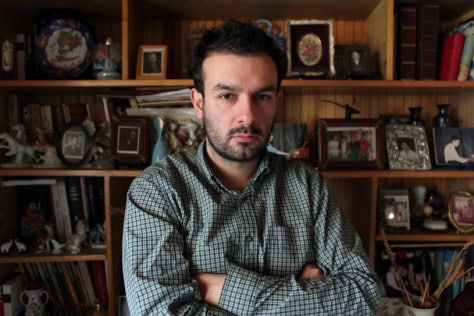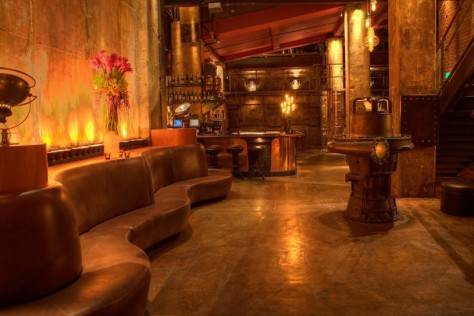While Our Legacy's homepage says the fashion house was established in 1980-1981, it's in fact a much newer label, forming officially in 2005. The Swedish company has made great strides in the three years since its inception, though, being retailed in a great deal of shops around the globe and slowly but surely becoming the A.P.C. of the Scandinavian region.
We interviewed co-founder Cristopher Nying and core member Richardos Rosén, two of the three brains behind the brand. Read it in full below and flip through some of the more recent photos of their Fall/Winter 2008 line in the media player to the right.
Tell me a little about Our Legacy's roots. Your website says the brand began in 1980-81! Is this really the case?
Cristopher: The years 1980-81 actually [represent] the years the founders of Our Legacy, Cristopher (81) and Jockum (80) were born. The company started out at first in 2005 with a tiny little T-shirt collection. We saw fashion as a fast communication tool and basically tried to express a whole look on each printed T-shirt, with a perfect fit and [Italian-made]. With this collection we managed to reach out to Scandinavian top stores, and so it began. The first complete collection was this Spring/Summer 2008 collection, so for us this counts as our first.
When you did start, what were your intentions? Some have described your aesthetic as “Swedish preppy” a la A.P.C. Do you think that description is accurate and in tune with your underlying goals and aspirations?
Cristopher: To create timeless garments in a natural, well-dressed, and comfortable way… not over-strained, nor too fashiony; conservative but playful and relaxed in expression; sophisticated yet light and nonchalant; made to look thrown together in a perfectly natural way…
I can see why people describe us as preppy. Preppy for us means that there is no room for mistakes and everything has to be slick and perfect from [head to toe]… but then you always have to worry where you can hang up your blazer to keep it smooth! Our Legacy, rather, puts the “unlined” blazer in the duffel bag and lives with a blazer that gets a bit wrinkled, through everyday use. Preppy from a distance may be the phrase.
A.P.C has a interesting company structure and besides that, they are one-hundred times bigger. The similarity may be that we both are seen as a “product” rather than a seasonal fashion [houses]. A “product” tends to use other layers to express itself and so on… such products don't really need to [incorporate] the seasonal trend and are often timeless.
What's the deal with The Swing of the Pendulum? You seem conceptually-driven… how did The Swing of the Pendulum come about and what were you trying to express with it?
Cristopher: The Swing of Pendulum is an extension of the “When Time Flies By 2007” collection. Its about how you can't really define time. Weather it is an inherited garment from your grandfather or from the 20th century.
I think we are good at criticizing ourselves. When it comes to the actual garment, we don't cross the line to overdo it, to make three arms on a sweater. We try to look at the human being and what he needs and voila, there are only two arms!
Instead of having a fashion show, we, together with the Swedish author David Permén have written Short Story Book [which is] about Our Legacy's fictive man, Sean de Germand. Sean moves from the conservative Oxford, England to an experimental world in Paris where he gets more and more involved in the art scene, and, for the first time, he feels that he has to come home. The story describes the collection and how your mood can influence you. We deliver our shirts folded very narrow, and in the story it describes why Sean's shirts are folded in this way; it's because the wardrobe shelf is so small! For those who have the patience to read this story, they can fantasize their own look and environment since there aren't any pictures.
While you still constrict your clothing lines to the traditional fashion schedule, you don't seem typical in any other sense. Are you trying to break, rejigger, or reinterpret the fashion “system” or just having fun with making clothes, shooting sexy lookbooks, and pushing the edgy?
Cristopher: We are still young and there is a lot left to give and learn. Combining our craftsmanship and the simple functions from our clothes together with the conceptual communication is one of the most important aspects. This makes Our Legacy typical, but through using our interests and what we like besides being well dressed, [we set ourselves apart]. There is something beautiful in everything (as pretentious as that may sound).
In our office we often eat pasta bare-chested and are otherwise very dressed down. So the look book is our only shield. In the end, we are making clothes for ourselves most of the time and, as the Gucci Group said, “the quality is always remembered before the prize.”
Richardos:That's a tough question! I think that you have to adjust to some things. I mean, if you want to do clothes, it's hard not to be a part of the fashion scene. If you want to sell your clothes—which you have to at some point to make a living—you have to attend fairs, sell the collection [at certain times and for certain seasons], plan the production, and so on. Reinterpreting the fashion system is an interesting point of view. I think it's important to know why you are doing things. It's one thing, making clothes, and it's another thing showing your clothes on a catwalk in front of a fashion crowd, making a big thing out of it. I don't say it's wrong, but maybe it's not our way. “Just having fun with making clothes, shooting sexy lookbooks, and pushing the edge” is also what we are doing. It's a really important aspect.
You claim to draw inspiration from “1950s expressionist authors and artists” and “modern tales from Africa―aesthetics of colonialism.” What draws you to these subjects and how do they speak to your sensibilities, style?
Cristopher: The gentle colors and dust-repellent clothes from the colonial country side, translated into a modern [sensibility]… the city style use―that was quite interesting [to us]. We associate colonialism with antique furniture and animal trophies, so I guess that the animals (the Illustrated line) are having their last supper―or their revenge.
For the Fall/Winter collection there is a completely different visual change, but it is still same grounded principle. Jaques Cousteau is important for this collection, a man who actually [was active] while stylish and ironic. [Check out] Odyssey by Jaques Cousteau or Life Aquatic by Wes Anderson.
Richardos: As for the “1950s expressionist authors and artists,” that's a constant source of inspiration. In short, the way they were really well-dressed and classic, a bit conservative, yet so relaxed. That's exactly how we want our clothes to feel. “Modern Tales from Africa… ” was an inspiration for the S/S 2008 line… mostly the printed line.
Sweden is increasingly becoming a fashion center of sorts. While there's a lack of big name designers in the country, there's an astounding number of small, high-end producers and refined designers (as well as the much-loved Cheap Monday). What is it that puts Sweden in this place? What is it that makes up-and-coming fashion houses strive for widespread acceptance and high price tags, but stray from the highfalutin runways of Paris, New York, London… ?
Cristopher: Swedes are generally very good at catching up with things… catching up with inspiration and using it with a limit. There has always been a pressure [to aspire towards] perfection within this small population, and as a result, it takes quite a lot to reach out. Since it is a very small place to create something new, Swedes have been forced to use simple yet reliable means. There are many Swedish brands we have to thank for putting Sweden on the fashion map, small and big.
How are you expanding the brand today? What efforts are you making to bring Our Legacy to more people?
Cristopher: We are going to focus on the international market more. Having [the line spread amongst fewer yet more superior shops] instead of aiming [for] one specific market. [We want to] be very careful with the distribution and “hurry slowly.” We are retailed in approximately fifty stores in fifteen countries. Internationally, we are represented in stores such as Beams International Gallery in Tokyo, Japan, Apartment No. 9 in Chicago, U.S.A., and Oi Polloi in Manchester, U.K. Price-wise, we are in the lower segment of the high-end level.
You used to make a magazine of sorts. Can you tell me about that? What was the inspiration behind putting together a book filled with gorgeous photos? Have you made more? Have you explored other non-fashion means of getting the Our Legacy name out there (film, exhibits, blogs, etc.)?
Cristopher: Our Legacy is going to start publishing photography books [in collaboration] with Tony Cederteg, so this may be the answer. The book was photographed by Tre Dadlar. Also, our website will soon have a massive makeover.
 Q&A with Larry Gus
Q&A with Larry Gus We Own the Night: The Edison
We Own the Night: The Edison
No Comments